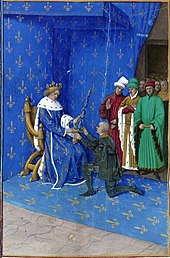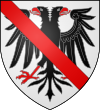Bertrand you Guesclin

Bertrand du Guesclin (* around 1320 in La Motte-Broons Castle near Dinan ; † July 13, 1380 in front of Châteauneuf-de-Randon / Auvergne ) was an important Breton military leader and Connétable of France . Thanks to his military successes in the Hundred Years War between the crowns of England and France , he went down in legend as a "knight without blame or blame" and achieved the status of a national hero in the collective memory of the French. According to contemporaries, he was an unusually ugly man, but even as a youth he was a powerful and brutal warrior.
Surname
The correct spelling of his name is by the way not certain. Although “du Guesclin” has prevailed among historians, it is usually called “Claquin” or, more rarely, “Glaquin” in texts of the late Middle Ages. He himself simply drew with "Bertran".
Life
Bertrand Du Guesclin initially fought in the Breton War of Succession (1341-1364) on the side of Charles von Blois , who, supported by the French king, challenged Duke John IV of Montfort, who was allied with the English . He first made a name for himself in 1357 when he successfully led the defense of the city of Rennes against English troops. He was then appointed by Charles of Blois to command Pontorson and Mont Saint-Michel .
Around 1360 he acted as commander in chief of Charles' troops in Normandy , Anjou and Maine . After he defeated King Charles the Evil of Navarre in the Battle of Cocherel (today Houlbec-Cocherel ) on May 16, 1364 , a rival to the throne of the new French King Charles V , who was also allied with England, and thus robbed of his hopes for the French crown Charles V made him Count of Longueville and Royal Chamberlain .
On September 29, 1364, Du Guesclin was captured by Johann V of Montfort at the Battle of Auray , in which Charles von Blois fell . The high ransom (100,000 francs) for which he was ransomed by Charles V shows his reputation at that time.
Since the war for Brittany had come to an end with the death of Charles von Blois, Du Guesclin was commissioned by King Charles V in 1365 to collect the mercenaries ( Grandes Compagnies ) marauding in France and bring them to Spain. There they were supposed to support the pretender to the throne Heinrich von Trastámara in the fight for the crown of Castile against his half-brother Peter I , who in turn was allied with England and had the largest navy in Western Europe.
After a successful campaign in 1366, Heinrich and Du Guesclin were defeated by a Castilian-English army in the Battle of Nájera in 1367 and the latter was captured. In vain, correctly assessing the tactical superiority of the English troops under the strategist Sir John Chandos and the unreliability of the thrown together troops on his own side, he had advised against an open battle and proposed to hide in the mountains, block the passes and so on to prevent English advance. The last to defy the English at Nájera were Du Guesclin and his people. In this way he also covered Heinrich's retreat, who was able to save himself alive, and finally surrendered.
Once again ransomed by Charles V, he defeated Peter in 1369 at the Battle of Montiel , in front of the fortress of the same name. During the subsequent negotiations between the half-brothers, he was unaffected by how Peter was murdered. The grateful Heinrich, now Heinrich II of Castile, rewarded him with the title of Count von Molina . With the subsequent support of France by the Castilian fleet, he had also achieved the political goal of his mission.

On his return home in 1370, Charles V awarded Du Guesclin with the dignity of a connétable of France , d. H. the highest military grade. In the following ten years he waged a tactically wise war of attrition against the English troops in the country, which finally secured his fame as a general. He took fortress by fortress from the English, only Bordeaux , Cherbourg and Calais could hold them.
On July 13, 1380 he died suddenly during the siege of Châteauneuf-de-Randon , allegedly because he had been overheated and drank too much cold water. He had expressed a wish to be buried in his native Dinan , Brittany , but for practical reasons his body was buried after the " Separate Burial " ceremony .
Four graves
The body was for transferring conserved , the intestines removed and placed in the Dominikanerkirche of Le Puy-en-Velay were buried. However, the preservation was unsuccessful and the body began to disintegrate during the transfer. In Montferrand the meat was finally cooked from the bones according to the mos teutonicus and buried in the local Franciscan church. The heart was removed beforehand. Because of du Guesclin's services to the kingdom, the French King Charles V ordered the remains to be buried in the royal tomb of Saint-Denis near Paris. The heart, on the other hand, was buried according to his wishes in his Breton homeland, in the Dominican church of Dinan; later the resting place was moved to the church of Saint Sauveur in Dinan.
When the royal tombs of Saint-Denis were sacked during the French Revolution , his grave was opened and robbed on October 20, 1793, and his remains were buried in a mass grave outside the church.
Marriages
- 1361: Tiphaine Raguenel (around 1335–1373)
- 1374: Jeanne de Laval-Tinténiac (around 1360–1433)
Both marriages remained childless.
See also
- Leaded glass window in the castle chapel: Life of Bertrand du Guesclin (Les Iffs)
literature
- Michael Jones (Ed.): The letters, orders and musters of Bertrand du Guesclin. 1357-1380. Boydell, Woodbridge, et al. a. 2004, ISBN 1-84383-088-4 .
- Richard Vernier: The flower of chivalry. Bertrand Du Guesclin and the Hundred Years War. Boydell, Woodbridge, et al. a. 2003, ISBN 1-84383-006-X .
Web links
- Bertrand du Guesclin - biography (French)
Individual evidence
- ↑ Bertrand du Guesclin, death - information
- ↑ Bertrand du Guesclin, Death and Tombs - Pictures + Info
| personal data | |
|---|---|
| SURNAME | Guesclin, you Bertrand |
| BRIEF DESCRIPTION | French general |
| DATE OF BIRTH | around 1320 |
| PLACE OF BIRTH | La Motte-Broons Castle near Dinan |
| DATE OF DEATH | July 13, 1380 |
| Place of death | Châteauneuf-de-Randon |

